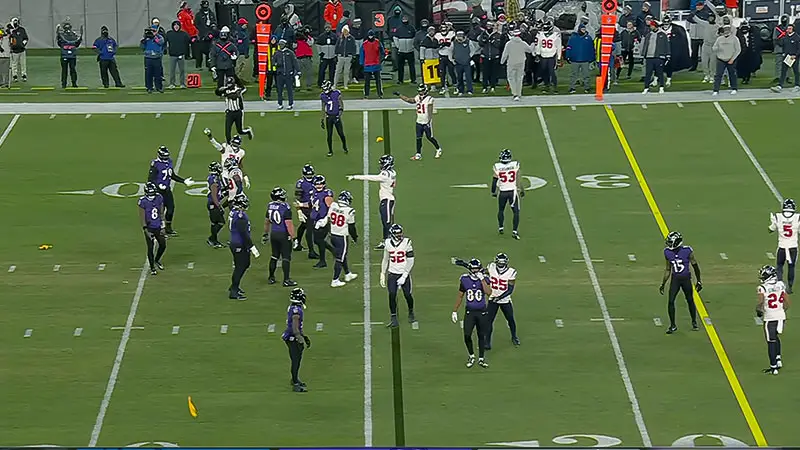Football’s intricate rulebook can sometimes feel overwhelming, but understanding the basics is crucial for both players and fans. Among the various infractions, 5-yard penalties are some of the most common and can significantly impact the flow of the game.
These penalties might seem minor, but they often play a pivotal role in the strategy and outcome of each play.
From false starts to offsides, knowing the types of 5-yard penalties helps in grasping the nuances of the sport. This guide dives into the specifics of these penalties, offering a clear and concise list that will enhance your football knowledge and viewing experience.
Whether you’re a seasoned fan or a newcomer, this breakdown will illuminate how each 5-yard penalty affects the game. Let’s explore the key 5-yard infractions you should be aware of to better appreciate the sport’s intricacies.
Overview of 5 Yard Penalties in Football
Understanding 5-yard penalties is essential for anyone serious about football. These penalties, though seemingly minor, can drastically alter the game.
Definition and Significance
A 5-yard penalty in football involves moving the ball 5 yards closer to the offending team’s end zone, disrupting both offensive and defensive strategies and affecting play outcomes.
Common 5-yard penalties include false starts, offsides, and delay of game, each capable of halting momentum and forcing rapid adjustments. Understanding these penalties is crucial for players and coaches to minimize errors and maintain strategic advantages.
Coaches often drill players extensively on common 5-yard penalties to enhance awareness and lessen costly mistakes. Additionally, knowledge of these infractions aids fans in grasping game dynamics more thoroughly.
Common Types of 5 Yard Penalties
False start penalties occur when an offensive player moves before the snap. Offsides penalties happen when a defensive player crosses the line of scrimmage before the snap.
A delay of game penalty is called if the offense isn’t ready to snap the ball before the play clock expires. Having just 5 yards of difference can shift momentum.
| Penalty Type | Situation |
|---|---|
| False Start | Offensive player moves before the snap |
| Offsides | Defensive player crosses the line of scrimmage before the snap |
| Delay of Game | Offense exceeds time allowed before snapping the ball |
Encroachment is called when a defensive player makes contact before the snap. Too many men in the huddle refers to having more than 11 players in the offensive huddle. Each affects the game in distinct yet impactful ways.
Misstep penalties add strategic layers for both players and coaches. Recognizing these nuances improves understanding of football dynamics.
Offensive 5 Yard Penalties
Offensive 5-yard penalties significantly impact a football game’s flow. They can stall drives and shift momentum.
False Start
A false start occurs when an offensive player moves after setting before the snap, such as linemen flinching or receivers stepping forward, disrupting offensive rhythm and leading to difficult situations.
Offsides is another common 5-yard penalty, occurring when a player crosses the line of scrimmage before the snap, giving the opposing team a tactical advantage.
Encroachment, a 5-yard penalty as well, happens when a defensive player contacts an opponent before the snap, often extending drives for the offense and shifting momentum.
Illegal Formation
Illegal formation happens when the offense doesn’t align according to NFL rules. At least seven players must stand on the line of scrimmage during the snap. Instances include having too few players on the line or covering up an eligible receiver.
These mistakes can negate successful plays and push the offense back. False starts occur when an offensive player moves illegally before the snap. Common actions include sudden jerks or shifts that simulate the start of play, resulting in a 5-yard penalty.
Delay of Game
Delay of game occurs when the offense fails to snap the ball before the play clock expires. Often caused by miscommunications or late substitutions, this penalty wastes valuable downs.
It can disrupt game tempo and frustrate both coaches and players, making it a critical aspect to manage efficiently. Another common 5 yard penalty is a false start, which occurs when an offensive player moves illegally before the snap.
This infringement can stall offensive momentum and result in unnecessary setbacks.
Defensive 5 Yard Penalties
Defensive 5-yard penalties are common infractions that can provide offensive teams with easy yardage and disrupt defensive momentum. These penalties can change the course of the game by giving the offense an advantage without earning it through play.
Offside
Offside occurs when a defensive player crosses the line of scrimmage before the ball is snapped. The result is a 5-yard penalty against the defense. Linebackers and linemen are most commonly caught in this position.
Timing the snap count and maintaining discipline on the defensive front is essential to avoid this penalty. Another common 5-yard penalty is a false start, which happens when an offensive player moves illegally before the snap.
This infraction disrupts the flow of the game and sets the offense back.
Encroachment
Encroachment happens when a defensive player makes contact with an offensive player across the line of scrimmage before the ball is snapped. This leads to a 5-yard penalty. Defensive tackles often face this penalty, especially when attempting an aggressive rush.
Defenders must watch for the snap and avoid premature movements to stay clear of encroachment calls.
False start, on the other hand, is a 5-yard penalty called against the offense when a player moves illegally before the snap. It’s crucial for all offensive linemen to remain stationary until the play begins to avoid costly mistakes.
Neutral Zone Infraction
A neutral zone infraction occurs when a defensive player causes an offensive player to move before the snap by entering the neutral zone, resulting in a 5-yard penalty on the defense.
This is common along the defensive line, where players must wait for the ball to move to avoid the infraction. Another 5-yard penalty is the false start, happening when an offensive player moves illegally before the snap, disrupting the offense’s timing.
Coaches stress discipline and composure to reduce these errors.
Special Teams 5 Yard Penalties
Special teams in football play a crucial role in field positioning and momentum. Understanding 5-yard penalties in this context can help teams maintain an advantage.
Kickoff Out of Bounds
Kickoffs are crucial for establishing field position, but a kickoff out of bounds incurs a 5-yard penalty, potentially giving the receiving team a significant advantage. This penalty usually results from a miscalculated strategy.
Avoiding it demands careful planning and execution. Similarly, false starts, another frequent 5-yard penalty, can disrupt offensive momentum.
They occur when an offensive player moves before the snap, resulting in a yardage loss and the down being repeated. Preventing false starts requires clear communication and disciplined practice.
Running into the Kicker
Running into the kicker is a 5-yard penalty that does not automatically result in a first down but can benefit the kicking team unless frequently repeated. This penalty often occurs from incidental contact when a defender tries to block a kick.
To avoid it, teams approach the kicker with control. Other 5-yard penalties, such as delay of game and encroachment, can disrupt momentum and give the opposition a tactical advantage, highlighting the importance of discipline and awareness in the game.
Understanding Penalty Enforcement
Enforcing penalties in football ensures fair play and maintains the game’s integrity. Different penalties have distinct rules and impacts, which players and coaches must understand.
Rules of Enforcement
Penalties are enforced according to specific guidelines. Defensive penalties like offside are enforced from the spot of the foul, while offensive penalties like a false start are enforced from the line of scrimmage.
If the quarterback commits intentional grounding, the penalty results in a loss of down and yardage from the spot of the foul. For special teams, a kickoff out of bounds leads to the receiving team starting at their 40-yard line.
Each type of penalty is handled differently depending on the circumstance.
Impact on the Game
Penalties can drastically impact a game’s outcome by hindering an offense or aiding the opposing team. False starts push offenses back, making third-down conversions harder, while defensive penalties like encroachment provide easy first downs.
Special teams penalties, such as running into the kicker, extend drives for the kicker’s team. Illegal shifts result in a five-yard loss, and delays of the game can stall drives.
Proper awareness and discipline are essential to minimize these penalties and maintain offensive efficiency, giving teams a competitive edge.
Frequently Asked Questions
What are 5-yard penalties in the NFL?
5-yard penalties in the NFL include infractions like false starts, offsides, encroachment, and delay of game. These penalties can disrupt the flow of a game and force teams to adjust their strategies.
How do defensive 5-yard penalties impact the game?
Defensive 5-yard penalties provide easy yardage to the offense, helping them move down the field. These penalties can disrupt the defensive team’s momentum and put them at a strategic disadvantage.
What are common offensive 5-yard penalties?
Common offensive 5-yard penalties include false starts and illegal formations. These penalties are enforced from the line of scrimmage and can lead to a loss of down and distance.
How can special teams be affected by 5-yard penalties?
Special teams 5-yard penalties, like a kickoff out of bounds or running into the kicker, negatively impact field positioning and momentum. Proper execution is crucial to avoid these penalties.
How are penalties enforced differently for offense and defense?
Offensive penalties are enforced from the line of scrimmage, while defensive penalties are enforced from the spot of the foul. This difference affects how yardage is assessed and penalized.
Conclusion
Grasping the nuances of 5-yard penalties in football is crucial for players and coaches, as these minor infractions can significantly impact the game’s flow and outcome.
By understanding the specific rules and effects of each penalty, teams can better strategize and minimize costly mistakes, maintaining discipline to ensure fair play and competitiveness. Special teams also need to be aware of penalties’ effects on field positioning and momentum.
Common 5-yard penalties include False Start, Offside, Encroachment, Neutral Zone Infraction, and Delay of Game. Thorough knowledge of these penalties helps teams stay ahead and maintain control on the field.
By enforcing these rules, referees maintain the integrity of the game. For instance, a False Start disrupts the timing of plays, while Offside and Encroachment can result in a loss of yardage that forces teams to adjust their tactics mid-game.








Ashley Hopkinson